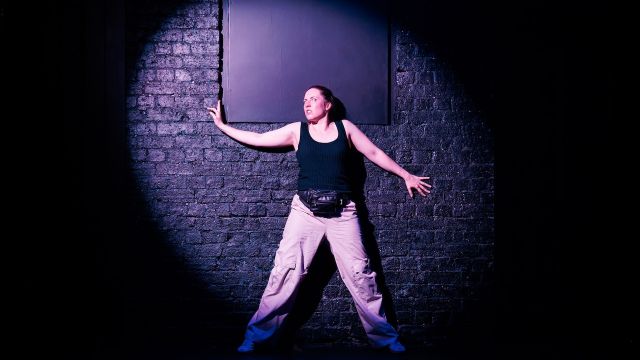Nu Disco
One night in a disco somewhere. For some reason the door bitch is a German cliche, unsmiling and tough. She makes us laugh – nervously. She disappears and Trinity (Ellen Marning) plunges into the disco and is at once enveloped in the ambient cocoon, in the lights that ripple across her face and the bodies of the dancers and the drinkers, and the repetitive, heavy bass nu-music music like a thudding heartbeat…
In a 2022 interview, Ellen Marning described her semi-autobiographical character, Trinity (three parts in one, you see) in Nu Disco as ‘late 20s, confused, horny, lonely, full of bravado, full of questions, full of rage she can’t quite place.’ Although this is the third iteration of Nu Disco, the description still seems accurate.

But Marning has added more characters that Trinity meets in the course of her night: the afore-mentioned German door bitch, a tipsy, ditzy lover girl, a kind and protective older woman, and a handsy Irish guy. All created for us by Marning herself – and what makes each of them vivid is her choice of telling detail. One example: the sweaty, balding Irish guy wears a Rolex watch. Get it?
Marning also demonstrates her range here. In Surat-Suratnya (also at La Mama), she was a quietly terrified, determinedly controlled Australian woman about to escape from Indonesia with her children at the time of the ant-leftist purges.

But in Nu Disco, one extraordinary aspect of her performance is the degree of control she exhibits in her every single precise and detailed movement of her body and her marvellous face. You cannot take your eyes off her. There are her dance moves, from tentative, to ecstatic, to awkward, to smashed. And there are her facial expressions from hopeful, to scared, to repulsed and despairing. She intrigues us. We laugh at her. She’s a human body busting for a pee. And we fear for her.
In creating this character and the others she encounters, the contribution of Robert Downie’s insistent, disturbing sound design is crucial, as is Cole McKenna’s intricate, detailed, changing from-moment-to-moment lighting that points up the quicksilver moves from character to character and from mood to mood. Marning’s long time collaborator Laura McAloney and her dance and movement facilitator, Arabella Frahn-Starkie, must have, one suspects, monitored every moment for clarity and emotional truth.

It's that clarity that makes us care about Trinity, this bewildered, silly but resilient young woman caught in the throbbing disco beat. Why is she there? The first answer is that Trinity, like her creator, just loves to dance – to move, to be inside the beat, to shake it out, to sweat and lose awareness of self and surroundings.
At first, that is why I figured Trinity is there: to escape from herself, to put aside or put on hold, loneliness, unanswerable questions and rage. Drugs as well as dance are part of this.

But Nu Disco seems to move through three parts. First, that escape from self. Then there are those forces – oppressive, crushing, outside, in the world, that create such a sense of powerless anxiety and doom. But Nu Disco isn’t a performance about those things – so Marning doesn’t ‘deal with’ sexism, or inequality, or global warming. That would not have been drama; that would have been boot-faced agit-prop.
No, Nu Disco is about Trinity, this particular young woman, and what those forces mean to her. And that is why, in its final moments, Nu Disco is about the need to nurture and to be nurtured.
Michael Brindley
Photographer: Darren Gill
Subscribe to our E-Newsletter, buy our latest print edition or find a Performing Arts book at Book Nook.

